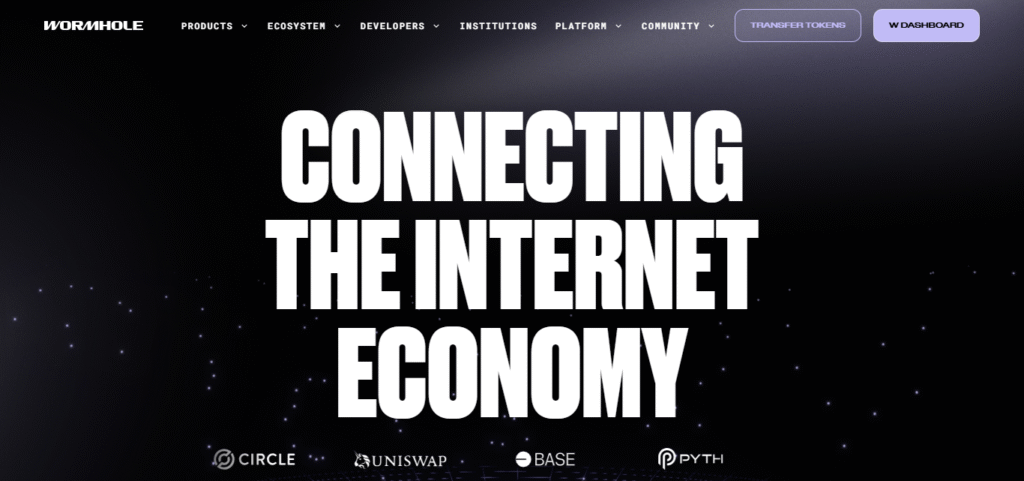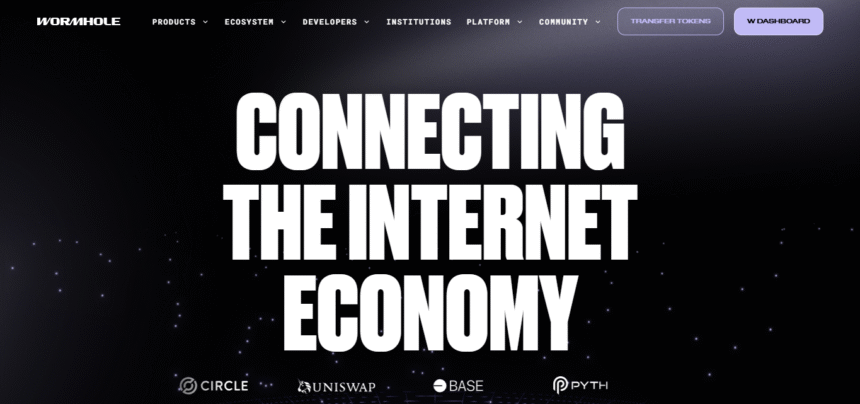In this article, I will analyze two powerful protocols in ‘Wormhole vs. Anyswap: Comparing Top Bridging Solutions’ so you can understand how they compete against each other.
Understanding the contrast between Wormhole and Anyswap becomes crucial when you are a developer creating cross-chain dApps or a user interested in seamless token movements in the dynamic universe of blockchain interoperability.
About Wormhole
Wormhole is a cross-chain, decentralized messaging protocol. It began as a bridge linking Solana and Ethereum, but currently accommodates more than 20 chains, like Avalanche, Polygon, BNB Chain, and Sui.
Wormhole supports cross-chain transfers of data, NFTs, and even governance messages, going beyond merely token transfers. The system relies on the guardians of the network to authorize data transfers and assure safe and accurate transaction validation.

Strong efforts in API development and interoperability of the system makes the creation of multichain applications easier, positioning Wormhole as an important building block on the modern Web3 architecture.
About Anyswap
Anyswap, which is now known as Multichain, is one of the first protocols enabling cross-chain bridges with an over 80 blockchain asset transfers. Established in 2020, it employs Secure Multi-Party Computation (SMPC) to decentralize custody and perform secure cross-chain transaction processing.
Unlike traditional lock and mint bridges, Multichain operates a liquidity router, allowing for swift and economical token swap. Its straightforward and wide compatibility interface makes it famous among both DeFi users and developers in the crypto space.

In comparison to EVM chains, non-EVM chains are also supported, which helps Multichain propel the development of blockchain interoperability and increase the movements of crypto assets within the cryptocurrency ecosystems.
Origins and Evolution
As a cross-chain messaging protocol, Wormhole started off supporting Solana and Ethereum and has developed into a token bridging platform over the years.
Jump Crypto’s team has worked on it extensively and it now supports more than 20 chains including Aptos, Avalanche, and Binance Smart Chain.
Wormhole has now shifted focus from token bridging to data movement and application building to foster the growth of multichain applications.
Anyswap, now Multichain, started off with a simple yet powerful motto – enabling seamless cross blockchain token transactions.
Their vision evolved into a sophisticated infrastructure that provides decentralized cross-chain routers (CRP), interoperability between smart contacts, and liquidity services. Multichain with its strong developer support and community makes claim to over 80 chains.
Core Technology
Wormhole employs a distributed system of guardians—a group of nodes that watch a chain and verify its events for a different chain. When a user wishes to transfer assets from Chain A to Chain B, these guardians check that the relevant transaction has taken place and they relay the message after confirming that the asset has either been locked or destroyed. A wrapped version is then minted on the destination chain.
Strengths:
- Pervasive message propagation
- Infrastructure for cross-chain dApps is easy to implement
- Multiverse incorporation—data, NFTs, tokens
Anyswap / Multichain’s Model
Multichain functions using SMPC nodes (Secure Multi-Party Computation) which hold private keys and perform cross-chain transactions in a collaborative way.

Its bridge resembles a liquidity router much more than a locking and minting bridge — it swaps assets in liquidity pools instead of locking and minting, making transfers faster and cheaper most of the time.
Strengths:
- Supports massive number of blockchains
- Fast transaction finality
- Decentralized custody via SMPC
Security and Reliability
Security is everything in the bridging world, and both protocols have had their battles.
Wormhole suffered a major hack in February 2022 when its Ethereum smart contract was exploited for $320 million. Afterward, Jump Crypto filled the gaps with new guardians and increased audits and decentralization.
Multichain had its fair share of issues as well with some scrutiny on the centralization of the SMPC nodes. Users also faced issues from certain nodes going offline which caused stuck transactions.
Use Cases and Ecosystem
Wormhole: Preferred by developers for multichain dApps, NFT bridging, and DeFi protocols requiring advanced cross-chain communications. Its integrations with Solend, Saber, and Portal bridge provide a robust infrastructure layer.
Multichain: Has a focus on token swaps and liquidity bridging. Powers numerous DeFi applications and centralized exchanges that require quick transfers of assets between networks.
Verdict: Wormhole is ideal for developers; Multichain is better for more users needing straightforward movement of digital assets.
Speed, Fees, and User Experience
Wormhole: Achieves near-instant transaction times but attached fees may fluctuate greatly during periods of Ethereum network congestion. User Interface differs based on integration; since it’s a protocol and not an application, the UI isn’t unified.
Multichain: Clearly listed on multichain.org, it provides direct user interface with fast swaps and generally lower fees from its liquidity pool structure.
Wormhole vs. Anyswap: Feature Comparison
| Feature | Wormhole | Anyswap (Multichain) |
|---|---|---|
| Bridging Mechanism | Lock-and-mint via cross-chain message passing | Liquidity-based swapping using liquidity pools |
| Validator Type | Decentralized Guardian Network | SMPC (Secure Multi-Party Computation) nodes |
| Supported Blockchains | 20+ (including Solana, Sui, Ethereum, Avalanche) | 80+ (wide coverage of EVM and non-EVM chains) |
| Cross-Chain Capabilities | Tokens, NFTs, arbitrary messages, governance | Primarily token transfers |
| User Interface | Protocol-level (UI depends on integrations) | Direct user interface at multichain.org |
| Developer Focus | Strong dev tools for dApps, cross-chain data, NFT projects | Focused more on simple token bridging for users |
| Transaction Speed | Fast (dependent on network congestion) | Generally fast due to liquidity-based model |
| Fees | Varies by network (gas + relayer fees) | Usually lower fees due to pooled liquidity model |
| Security Approach | Verified by guardian consensus | SMPC node consensus; some centralization concerns |
| Notable Incidents | $320M exploit in 2022, later reimbursed by Jump Crypto | Network disruptions and stuck funds in 2023 |
| Use Case Focus | Ideal for developers building multichain apps | Best for users doing fast, simple asset transfers |
Conclusion
To summarize, Wormhole and Anyswap (Multichain) have different functionalities within the cross-chain world. As a developer-focused protocol, Wormhole stands out during complex interactions like NFTs or data messaging cross-chain.
In comparison, user-friendly Multichain concentrates on providing speedy and effective token transfers to a greater number of blockchains.
Your preferences determine which option is ideal; either Wormhole is chosen to construct multichain dApps, or Multichain is selected for effortless day-to-day transactions.
They are both essential in bolstering blockchain ecosystems and in working towards a more unified and interconnected Web3.








